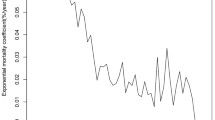Abstract
We examined the response of forest tree species with different dispersal modes to anthropogenic pressure in a dry deciduous forest of South India. The species and their populations were sampled in two forest stands, one in proximity to a Soliga settlement (greater disturbance) and the other distant to the settlement (lower disturbance). Our results suggest that the populations of animal dispersed species than those of wind or passively dispersed species are more vulnerable to human disturbance. In fact wind dispersed species seem to be facilitated by human disturbances. The proximal site had a higher representation of understory plants and seedling belonging to wind dispersed species than that of animal dispersed species. We discuss the results in the context of the role of dispersal mode in shaping species response, and vegetation composition of forest to anthropogenic pressures.
Similar content being viewed by others
Literature Cited
Daniels, R. J. R., M. Gadgil, and N. V. Joshi. 1995. Impact of human extraction of tropical humid forests in the Western Ghats in Uttara Kannada, South India. Journal of Applied Ecology 32:866–874.
Gamble, J. S. 1915–1934. Flora of the Presidency of Madras, 1–3, Adlard, London.
Gentry, A. H. 1980. Phytogeographic patterns as evidence for a Choco refuge in biological diversification in the tropics. Pages 112–136in G. Prance, ed., Columbia University Press, New York.
Gentry, A. H. 1982. Patterns of neotropical plant species diversity. Pages 1–84in M. K. Hecht, B. Wallace and G. T. Prance, eds., Evolutionary Biology: Volume 15, Plenum Press, New York.
Hedge, R., S. Suryaprakash, L. Achoth and K. S. Bawa. 1996. Extraction of non-timber forest products in the forests of Biligiri Rangan Hills, India. 1. Contribution to rural income. Economic Botany 50:243–251.
Kruckeberg, A. R., and D. Rabinowitz. 1985. Biological aspects of endemism in higher plants. Annual Review of Ecology and Systematics 16:447–479.
Lokesha, R., R. Vasudeva, and A. N. Yellappa Reddy. 1991. Do rare/endangered/threatened plant species of south India have specific reproductive syndromes promoting their extinction? Proceedings of the Symposium on Rare, Endangered, and Endemic Plants of the Western Ghats. Trivandrum, Kerala.
Lokesha, R., and R. Vasudeva. 1992. Commercial exploitation—a threat to Indian orchids? Current Science 63:740–744.
Murali, K. S., Uma Shankar, R. Uma Shaanker, K. N. Ganeshaiah, and K. S. Bawa. 1996. Extraction of non-timber forest products in the forest of Biligiri Rangan Hills, India. 2. Impact of NTFP extraction on regeneration, population structure and species composition. Economic Botany 50:252–269.
Ramesh, B. R. 1989. Vegetation map of the Biligiri Rangan Hills French Institute, Pondicherry. Sokal, R. R, and F. J. Rohlf. 1969. Biometry. Freeman, San Francisco.
Uma, Shaanker, R., K. N. Ganeshaiah, and T. R. Radhamani. 1990. Association among the modes of pollination and seed dispersal—ecological factors and phylogenetic constraints. Evolutionary Trends in Plants 4:107–111.
Uma Shankar, K. S. Murali, R. Uma Shaanker, K. N. Ganeshaiah, and K. S. Bawa. 1996. Extraction of non-timber forest products in the forests of the Biligiri Rangan Hills, India. 3. Productivity, extraction and prospects of sustainable harvest of Amla,Phyllanthus emblica (Euphorbiaceae). Economic Botany 50:270–279.
Uma Shankar, R. Hedge, and K. S. Bawa. 1998. Extraction of non- timber forest products in the forests of Biligiri Rangan Hills, India 6. Fuelwood pressure and management options. Economic Botany 52:320–336.
Uma Shankar, K. S. Murali, R. Uma Shaanker, K. N. Ganeshaiah, and K. S. Bawa. 1998. Extraction of non-timber forest products in the forests of Biligiri Rangan Hills, India. 4. Impact on floristic diversity and population structure in a thorn scrub forest. Economic Botany 52:302–315.
Author information
Authors and Affiliations
Rights and permissions
About this article
Cite this article
Ganeshaiah, K.N., Shaanker, R.U., Murali, K.S. et al. Extraction of non-timber forest products in the forests of Biligiri Rangan Hills, India. 5. Influence of dispersal mode on species response to anthropogenic pressures. Econ Bot 52, 316–319 (1998). https://doi.org/10.1007/BF02862150
Received:
Accepted:
Issue Date:
DOI: https://doi.org/10.1007/BF02862150




